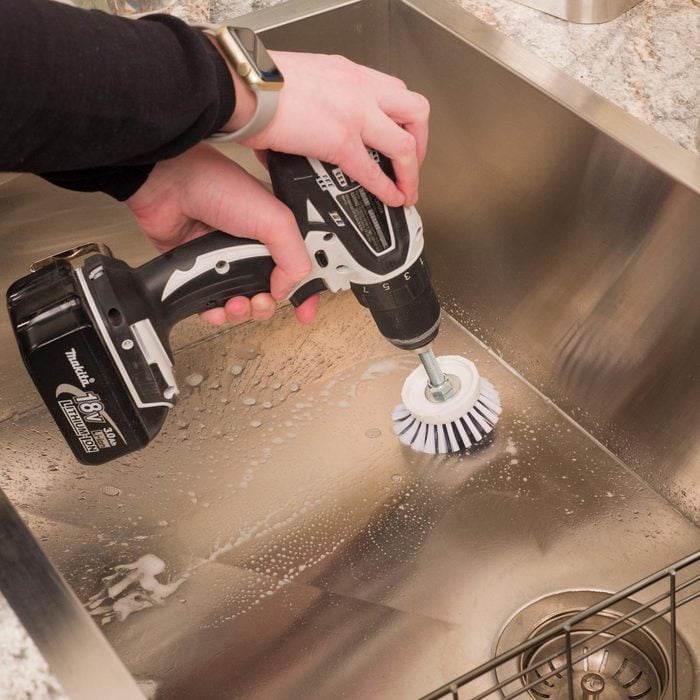When not properly cared for, the equipment and appliances we use to clean the house can spread bacteria and germs. Here’s how to clean your cleaning tools.
Dust Bunny Broom Cleaner
Every time you sweep, clumps of dust and hair collect at the ends of the broom’s bristles. To solve this problem, hot glue a wide-tooth comb to the top of a dustpan. Just run the bristles through the comb to remove any excess gunk dangling from the broom.

Clean Your Lint Trap
Even if you empty your dryer’s lint trap before each load, chances are there is still lint buildup around the area that could potentially start a fire. That’s why it’s important to deep clean the area once in a while. Here’s the best method we’ve found for cleaning out your lint trap. Wrap a clean rag around one end of a paint stir stick. Remove the lint trap and clean out the area with the rag-covered stick. To help the rag pick up the lint, dampen it with water first.

How to Clean Your Dish Brush
You use it to clean your dishes, but how often do you actually clean your dish scrubber brush? When not properly cared for, this tool we rely on for cleaning up in the kitchen can actually spread harmful bacteria. The trick is to make sure you’re getting the best clean possible. Clean your dish scrubber brush once a week in the dishwasher, or with a vinegar mixture.

The Drill Brush
You use your sink to clean dishes, but you won’t get anywhere if your sink is dirty, too. Clean it quickly with this drill brush hack.
To make this drill brush you’ll need a drill, a washer, a bolt, a long machine screw and a brush head replacement.
- Start by threading the machine screw through the brush head so the head of the screw rests in the brush head hole.
- On the other side of the brush head, slide on the washer and secure it in place with a nut.
- Make sure to tighten it with a wrench. Do not over-tighten, as this may cause the plastic brush head to crack.
- Attach the scrubber head to the drill.
To clean, fill a bowl or bucket with hot water and dish soap (or the cleaning agent of your choice). Dip the power scrubber into the mixture just enough to saturate the bristles — do not submerge the drill! Now point and press the drill to start and let the drill brush do the work.

Keep Your Toilet Brush Germ-Free
Toilet brushes are relegated to a filthy task, and the thought of what’s left on that brush made me a little queasy. So I put a splash of Pine-Sol in the bottom of the brush container. Not only does this help to deodorize my bathroom, but it also disinfects the toilet brush.

Sponges and Rubber gloves
These two can only be used for a week and still depend on the situation of the sponge and/or gloves, but ideally is to replace them every week. In order to keep it clean, rinse them first and have it soak in a hot water with white vinegar or lemon juice for 5 minutes and wash it again then let it dry.
NOTE: When a mop or scrub brush has been used for a really dirty job or used on a surface that can lead to cross-contamination, it needs to be cleaned immediately.

How to Clean Your Duster
No matter how hard we try to prevent it, dust happens. Dusters — whether cloth, feather, synthetic or disposable — are a necessity to keep your home as dust-free as possible.
So it makes sense to clean the dust out of your duster every now and then, unless you use a disposable duster such as Swiffer. Here’s how to clean your duster (the cleaning method varies depending on your duster’s material). Cleaning your duster regularly will not only prevent spreading that old dust around, but it will help keep your duster in good condition.

Storage
It is best to allot tools in each area so it won’t lead to cross-contamination. After cleaning the tools, store them according to their usage and never put a cleaning tool into storage until it’s ready for the next day’s project.
With proper care using a few of these tips, your cleaning tools will not only produce a better cleaning result, but will also have a more prolonged life, reducing costly replacement.
See the next article about the wrong cleaning habits you’ve to stop from doing.

Citrus Peels and Ice Cubes for a Stinky Disposer
You garbage disposal is great for cleaning up food in the sink. But if your disposer has developed an odor, it may be holding on to bits of rotted food. Here’s how to clean it out:
- With the water running at about half throttle, drop in orange or lemon peels. Run the disposer for five seconds. Citric acid from the peels softens crusty waste and attacks smelly bacteria. Give the acid about 15 minutes to do its work.
- Turn on the water and the disposer and drop in a few ice cubes. Flying shards of ice work like a sandblaster inside the disposer.
- Run the water until the bowl is about half full. Then pull the stopper and turn on the disposer to flush it out.

Clean a Vacuum with a Vacuum
The typical way to clean the filter of a bagless vacuum is to tap it against the inside of a trash can until most of the dust falls off. But that raises a cloud of dust and doesn’t get the filter completely clean. For faster, neater, more effective filter cleaning, use your shop vacuum. Clean pre-filter screens and post-filters the same way. Just remember to be gentle with the shop vacuum’s nozzle. Some filters have a coating that you can scrape off if you press too hard.

Mr. Clean Magic Eraser Bath Scrubber
You spend so much money on cleaners with bleach in them, only to scrub and scrub before your bathroom finally starts to sparkle. Take the effort and money out of cleaning with the Mr. Clean Magic Eraser Bath Scrubber. It features Febreze Freshness and can erase three times more soap scum than leading all-purpose spray cleaners.

Clean Inside the Dryer and Dryer Vent
Built-up lint inside dryer cabinets causes more than 15,000 fires every year. Lint escapes through tiny gaps around the edges of the dryer drum and falls into the cabinet, especially when the exhaust vent or vent cap is clogged and airflow is restricted. The lint can be ignited by electric heating elements, gas burners or even a spark from the motor, and the flames then travel through the lint-lined exhaust vent.

How to Clean Your Dishwasher
You’d think your dishwasher, post dishwashing, would already be clean. But you’d be wrong! Food bits find their way into all the nooks and crannies of your dishwasher, leading to bad smells and eventually poor cleaning of your dishes.

Clean Your Washing Machine
Just because you’re washing clothes regularly doesn’t mean your washer can’t use an occasional cleaning. Once a month, run an empty load with just hot water and bleach.

S-Hook Hang-Up
Once you’re done cleaning the house, your cleaning supplies need a place to stay clean and organized too. Pick up a pack of S-hooks at a home center and turn wire shelving into a rack designated for cleaning gear








